 The latest utility equipment releases give operators more control and operations
The latest utility equipment releases give operators more control and operations
more options. Above, MacLean’s
new pipe handler basket for the LR3 integrated
carrier can be attached quickly, and can transport, lift and rotate
pipes.
(Photo: MacLean Engineering)
The latest news from utility equipment
suppliers show what happens when OEMs
co-develop solutions with miner partners.
The resulting solutions deftly solve specifi
c challenges, inexpensively, and with a
nod to sustainability. They give operators
more control, and operations more options.
The typical list of benefits is topped
by cost savings or improved safety. Field
tests give clear wins.
The following stories also reveal that
OEM-miner partnerships result in solutions
that can simplify workflows and processes.
They bestow upon the manager
the chance to streamline. For operators,
they offer not just improved KPIs, but
improved job satisfaction. And, as one
expert told E&MJ, a happy employee is a
productive employee.
Turning Scaling Into
a Science
Hermann Paus Maschinenfabrik GmbH
announced the PScale 8-T, a compact
precision-scaler trialed and proven in
high-altitude mines in Peru and Chile.
The model is the evolutionary successor
of the Scaler 853. Paus said the
PScale 8-T was developed to deliver surgical
accuracy, and to operate in the tight
confines and extreme conditions that
define mines in the highlands of South
America.
“The best scaler in the world has gotten
even better,” Franz-Josef Paus, executive
manager, Paus, said. “It is a very
successful, well-established machine,
especially in South America. And if a machine
is Peru-proven, it is ready for the
rest of the world.”
The new scaler was designed to give
the operator a level of control that isn’t
offered by competitor machines. “The
key for our machine is its size, the maneuverability,
and the ability to really
sensitively operate,” Paus said. “The
operator has the chance to incorporate
all of his skills in terms of judging
where to work.”
The ability to deliver only the needed
energy and action to bring down loose
rock separates the PScale 8-T from the
competition, Oliver Wilke, sales manager,
Paus, said.
“What the competition has is a machine
with a scaling pick or a hydraulic
hammer in the front of it,” Wilke said.
“With either, this can create problems.”
Both can put too much energy into the
walls and roof. “You will destroy the natural
protection that is created when you
build a gallery,” he said.
In comparison, the PScale 8-T turns
scaling into a science. “With our machine,
you go to the point where you think
that it is necessary to scale, and then you
can do it on the point,” Wilke said.
“You don’t have to put so much energy
into the sidewalls and into the roof,” he
said. “Most other machines cannot handle
like that.”
Most other machines are too big to
maneuver easily, further limiting the options
of the operator. “If you are in Phase
A and you want to move to Phase B, with a
competitor’s machine it takes much more
time than with our scaler because our
scaler fits much better in smaller-sized
galleries,” Wilke said.
With a reach of 8 m, the PScale 8-T
is 8 m long, 2 m wide and 2.5 m high. It
has an internal turning radius of 2.5 m,
and an external radius of 4.6 m and could
be operated in galleries with a width of
less than 3 m.
Compared to its predecessor, the scaler
offers more power and improved safety. It has a 97-kW Caterpillar C4.4 engine.
With increased air flow, engine cooling
capacity is improved over that of the predecessor,
company literature stated.
The PScale 8-T has a new boom design,
with stronger geometry, that can
handle up to 400 kg. Compared to the
853 Scaler, it has a more robust chassis,
a stronger swiveling bearing, and
optimized articulation, the company reported.
The result is a power increase
of up to 30%, and improved precision
and production.
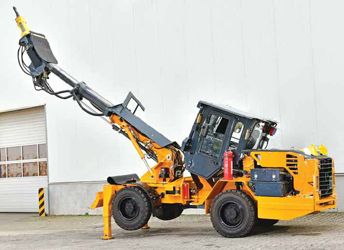 The compact PScale 8-T precision scaler was designed to give operators more control
The compact PScale 8-T precision scaler was designed to give operators more control
over where and how to scale.
Developed in Peru, it can handle heavy use in extreme
environments. (Photo: Paus)
Compared to that of the 853 Scaler,
the new cabin is better at cutting noise,
heat and vibration. The cabin is tilted at
20°. It offers “excellent visibility, easy
handling,” and a “relaxed atmosphere,”
the company reported.
“It is more productive and safer than
any machine in the market at the moment,”
Wilke said.
Those superlatives are the fruits of
two decades of research and development
driven by feedback from both the
Peruvian distributor Ferreyros and from
customer mines. “We were looking for
a small, maneuverable and quick machine,”
Paus said.
“Especially in narrow vein and other
applications, we were looking for a machine
that was able to go into small, confi
ned spaces, scale there, and then, when
the job is done, move quickly from one
site to another,” he said. Ideal was a machine
able “to use the operator’s skills in
terms of knowing where to scale, to what
extent, and to avoid any additional damage
to the rock.”
The scaler will be offered with optional
remote control or with a teleremote system,
and in the near future with sensor
packages, to include a loose rock detection
system.
“We are scaling on a higher level,”
Wilke said. “We were pioneers in mechanized
scaling, and have the experience
to help every customer with specific and
dedicated solutions.”
Ironically, the scaler’s genealogy traces
back to the 853 platform. The 853 is
the progenitor of the multifunctional TSL
853 T7. Ingeniously undedicated, “it is
the MacGyver of mining,” Hendrik Hörnschemeyer,
sales manager, Paus, said.
The TSL 853 T7, in its most basic
form, is a wheel loader; but with a swiveling
boom and telesecopic arm, it can
also be equipped to function as a forklift,
dozer, crane or sweeping machine.
That’s not all. It can operate a man
basket, a 4-in-1 shovel, a hydraulic hammer
or even a snowblower.
The backside can also be equipped
with attachments, and can lift up to 500
kg. “Based on this, we can create new
solutions together with clients,” Hörnschemeyer
said.
For example, a miner in the U.K adopted
it for ANFO charging applications.
“They previously needed one machine
for lifting up the people, and another
machine for carrying the ANFO unit,”
he said. “This we now combine into one
machine where the operator is in front
of the basket, loading holes, and from
there controls the unit attached to the
rear power lift and operates it as an ANFO
charging unit.”
It could also be configured to be a concrete
pump, Paus said. “A concrete pump
can be added to the rear part and have
the nozzle and the operator in the basket.
The machine can be controlled from the
cabin, from the basket or remotely.
The standard tool change takes 10
minutes or less. An optional hydraulic
hose quick-change device drops that to
less than a minute. The optional speedlock
system automatically connects
power lines.
“Ordinary power-consuming attachments
can be changed out in seconds,”
Paus said.
The machine is available with a Tier 4F/
Stage V-certified engine. Customized solutions
are available, the company reported.
“This machine is what we are,” Paus
said. “It can do basically everything. For
its versatility, its capability, and what it
makes possible, it is a very affordable machine.”
On-site Remans During Lockdown
In early 2020, Normet globally launched
its new remanufacturing program. The offering, which was trialed by a customer
in China in 2019, includes the option of
having Normet equipment rebuilt at the
mine site.
The trial tested the concept in “harsh
and isolated mining environments, where
extending the lifetime of an existing fleet
is an extremely viable solution,” Mika Nevalainen,
global product manager, remanufacturing,
Normet, said.
For the trial, the rebuilds were done at
a Normet hub, but they can also be done
on site in partnership with the customer.
If a site is located where transporting
equipment is difficult, expensive or even
prohibited, Normet can bring in the tools
and personnel to a dedicated work area at
the mine. “Remanufacturing at the customer
site both simplifies and minimizes
logistics,” Nevalainen said.
One option would be for the supplier
to create a workshop in a space provided
by the customer.
“Normet has a solution available
where we could setup a full movable
workshop,” Nevalainen said. “Obviously,
this is quite a large operation, and not
feasible with smaller scale programs. A
movable workshop requires cooperation
with local authorities.”
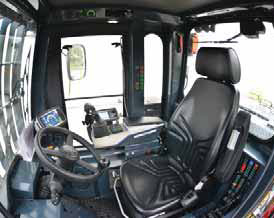 Tilted at up to 20°, the cabin for the PScale 8-T cuts
noise,
Tilted at up to 20°, the cabin for the PScale 8-T cuts
noise,
vibration and heat, and offers excellent visibility.
(Photo: Paus)
A bigger mine might provide a bay in
a service center that is already capable of
supporting a reman.
The average reman spans 16 weeks.
During that time, Normet Rental can provide
a temporary replacement machine
to help prevent any disruption to production.
“That provides an opportunity for
the customer to test the latest technology
available,” Nevalainen said.
A reman, whether done at the customer
site or at a Normet facility involves
several steps. First, the supplier
will disassemble and inspect the machine.
The core is then sandblasted and
repainted. Hydraulics and electronics
are replaced. Upgrades are recommended.
Testing follows. Lastly, the machine
is certified, the process documented,
and the data compiled.
“We pay attention to every detail,”
Nevalainen said.
The performance testing and documentation
process is the same as for new
equipment. The rebuild is certified to perform
like new.
“We grant a full warranty on the complete
machine,” Nevalainen said. “Additionally,
by adding the latest technology
to the core, the productivity, performance,
and operations experience can be raised
while reducing operating expenses.”
Compared to buying new, remanufacturing
costs roughly 30% less and
offers a 60% reduction in lead time. “By
using an existing core, changes to site
operations are minimized,” Nevalainen
said. “Operators already know the equipment,”
he said. “No major changes for
spare part demand planning and stocking
are required.”
Since the global release of the offering,
the pandemic and the ensuing restrictions
and shutdowns fueled demand.
For many customers, buying new
has simply not been a viable option for
months. “COVID has brought a lot of uncertainty
to all the markets,” Nevalainen
said. “This uncertainty has meant that
many customers have delayed their capital
investment decisions, including also
orders for new machines.”
For customers that were considering
a new-buy when the pandemic hit, the
restrictions and shutdowns further complicated
already challenging logistics
for importing and transporting equipment.
Customers in remote locations
effectively became even more isolated,
he said.
“A few of our teams have needed to
spend extra months on customer sites as
there has been no flights in and out of
remote sites,” Nevalainen said.
 Normet’s reman program offers on-site rebuilds, and can help isolated mines maintain
the needed equipment availability even when under tight travel and transportation
Normet’s reman program offers on-site rebuilds, and can help isolated mines maintain
the needed equipment availability even when under tight travel and transportation
restrictions. (Photo: Normet)
Simultaneously, in most countries,
mining and tunnel construction were labeled
essential business. “A majority of
operations have run continuously,” Nevalainen
said. “Hence, machines have continued
to operate normally.”
Market uncertainty, complex logistics,
and the need to operate uninterrupted
made on-site rebuilds that much more
attractive.
“Normet OEM remanufacturing at
the customer site or from the nearest
hub has become the solution in hand
to get maximum performance out of the
customer’s existing fleet and to help
mitigate future risks of breakdowns and
lost production,” Nevalainen said. Specifi
cally, “Normet China and our Latin
American teams have successfully,
during COVID, completed remanufacturing
programs to support customer needs
and help them to overcome challenges
with aging fleets.”
Other Normet teams elsewhere, such
as in the U.S. and Australia, are currently
ramping up to offer the program.
“Normet Finland, Chile and India are
leading the way in building the capabilities,”
he said.
The new program fits well into the
company’s history of servicing machines
throughout the entire lifecycle through to
recycling. “Remanufacturing aligns well
with all three targets of the Normet value
proposition: Securing a safe and sustainable
future, innovating for productivity
and partnering for lifetime value,” Nevalainen
said.
On the first, “Normet is leading
the way in sustainable and more environmentally
friendly solutions for customers
who are searching to improve
productivity and extend the lifetime
of equipment,” he said. “With remanufacturing,
our customers can support
circular economy, responsible manufacturing,
recycling and minimizing carbon
footprints. All of these are key drivers to
customer satisfaction.”
Versatile Carrier Adds Capabilities
MacLean Engineering released three
attachments for the LR3, making the
integrated tool carrier that much more
versatile.
“With several basket and attachment
options available and the ability to work
on both flat ground and inclined surfaces,
the LR3 is truly the Swiss Army
knife of underground machines,” Bryson
Lehman, product analyst, utility vehicles,
MacLean, said.
The company released a fork attachment,
a jib boom attachment and a pipe
handler basket.
The fork attachment has a frame design
that gives a clear sightline when
loading and unloading, MacLean reported.
“The adjustable forks can be positioned
to evenly distribute the load for
safe maneuvering.”
It has a 6,350-kg load capacity
and 60-in. tines, and offers hands-free
connection.
“The fork attachment can be used
for loading and unloading pallets from
deck trucks, loading ventilation fans into
cradles, and just about anything requiring
forks,” Lehman said. “One of the
biggest benefits of the fork attachment
is the high payload capacity as well the
ability to make the LR3 a self-sufficient
machine, eliminating the need for additional
machines.”
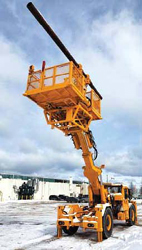 The new pipe handler basket for the
The new pipe handler basket for the
LR3 integrated tool
carrier has
adjustable claws, a tilting grapple
feature,
240° basket rotation, dual
control stations and the
ability to
store pipes. (Photo: MacLean)
The jib boom attachment is specifically
designed to assist in retrieving pumps,
loading fans on to cranes, and handling
large, bulky loads, the company reported.
It has a 7,000-kg load capacity, a
60-in. boom extension, and also offers
hands-free connection.
When used with the LR3’s boom
swing, lift and extension, it has a large
range of motion, Lehman said. With “a
maximum reach of 4 m, the jib boom is
ideal for getting into those hard-to-reach
places, such as sumps for retrieving
pumps,” he said. “The simple design of
the jib boom is what makes it the perfect
attachment for underground mining.”
The pipe handler basket “is the ultimate
basket to safely and productively
install pipes,” MacLean reported. It has
adjustable claws, a tilting grapple feature,
240° basket rotation, dual control
stations and the ability to store pipes.
The deck is 7 ft by 12 ft, has a
1,590-kg payload capacity, and has
safety posts and gates. It features
quick-connect hydraulics and electrical
cabling. A camera is mounted on the
front of the basket.
The basket is “designed specifically
for retrieving, lifting, and positioning
pipes of several sizes and lengths, ranging
from 4 in. to 10 in. in diameter and 4
ft to 20 ft long, in headings as high as 8
m,” Lehman said.
“The basket rotates to install pipe on
either side of the machine while allowing
for personnel to be situated in the basket
for quick and precise installation,” he
said. “All from one setup.”
The basket is a certified elevated work
platform, he said.
It is can haul pipes. “An operator can
load up several pipes into the basket and
drive them to the installation point,” Lehman
said. “This reduces the need for an
additional truck to deliver pipes.”
The clawed manipulator “can grab
pipes at ground level and lift them into
position in one smooth motion,” he said.
The basket delivers safety and effi-
ciency. “It is the final piece of the puzzle
for making the LR3 the ultimate mine
services and maintenance truck,” he
said.
The LR3 was announced in 2016 and
released in 2017. It was developed after
a study in Australia on dangers linked to
generic integrated tool carriers used as
elevated work platforms showed the need
for a dedicated solution. The carrier was
originally designed for use in Australia,
for the high-reach, heavy-load task of installing
ventilation fans.
Quickly it was adapted with tools and
attachments and deployed for a range of
applications. It can raise to 20 ft an 8-by-
12-ft work platform that can support up
to 5,400 kg.
The rig is 11 m long, 2.5 m wide, 2.5
m high, and has an inside turning radius
of 2.2 m, and an outside turning radius
of 8.2 m. The LR3 comes with the
company’s Remote Drive system, and is
described by the company as ideal for
large-heading mines.
Since its initial release in Australia,
the demand for the machine exceeded
original expectations, Lehman said.
“What we did not know is how much traction
the LR3 would gain worldwide,” he
said. “With machines currently working in three continents and soon to be five, the
safety features and versatility built into
the LR3 are a real game changer.”
Because it “can do it all, mines can
eliminate the need to purchase and upkeep
several machines, reducing overall
capital and ownership costs,” he said.
For that same reason, MacLean is
driven to further develop and improve
it, Lehman said. “With the LR3 being
as versatile as it is, it gives us the perfect
product to develop our ideas, with
additional tools and baskets already in
the pipeline.”
Shearing Scaler Reaches 11 M
GHH reported it has sold three of the
hefty, long-reaching LF-20HB shearing
scalers since the model was released
a year ago. Since the launch of the LF
series in 1996, roughly 120 units have
been deployed to potash and salt mines
around the world. Almost 90 are in use in
soft rock mines today.
The scalers are popular because they
straight-up outwork competitor models,
Guido Wolters, sales director, Europe,
GHH, said.
“One of our scalers replaces three to
four Oldenburgs and has a better performance
at the end of the shift,” he said.
In U.S. and Canadian mines, LF scrapers
can sometimes double the daily production
of competitor models, he said.
“High productivity at low costs and excellent
ergonomics result in satisfied operators,”
Wolters said. “Satisfied miners
are good miners.”
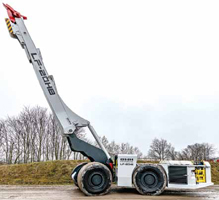 The LF-20HB shearing scaler was designed for a
The LF-20HB shearing scaler was designed for a
North American soft rock mining
customer that wanted
a LF scaler that could reach up to 11 m. (Photo: GHH)
The line launched with the LF-7.4B,
co-developed with K+S Potash Canada.
“We built more than 40 LF-7.4B scalers,”
Wolters said. “In 2012, we delivered the
first LF-7.6HB to our customers.”
The LF-7.6HB offered lower maintenance
costs in comparison to the predecessor
model. “The drive train of the LF-7.4B
was cost intensive due to the hydrodynamic
drive system,” Wolters said. “Especially the
standard design of the drive train using a
typical gearbox was less than optimal.”
The LF-7.6HB featured a new hydrostatic
drive system and greater stability,
he said. “The customer is really happy
with it.”
Besides lower costs, it offered several
advantages over its predecessor. “For
example, the soft change of the scaling
direction, or the much quieter vehicle operation,”
Wolters said. “The oil temperatures
are very low, and this allows us to
do much more hours between the maintenance
intervals.”
More than 80 have sold.
The first LF-20HB was deployed in
2019 to a customer requesting a shearing
scaler that could reach heights of up
to 11 m. “All other standard scalers are
for a maximum height of 8 m or less,”
Wolters said.
With a massive boom and offering
stability on inclines of almost 30%, the
rig weighs 58 mt and is based on the
chassis of a newly released GHH LHD.
In comparison, the LF-7.6HB weighs
34 mt.
The LF-20HB features a more comfortable
driving position, with joystick
steering and dedicated seats for comfortable
scaling. The cabin is described as ergonomic,
and offers optimal visibility and
safety. “The overview for the driver is very
good,” Wolters said. “Also the system is
ready for GHH inSite.”
An intelligent safety system protects
the operator and machine, the company
reported. Other optional assistance systems, such as collision avoidance, help
deliver optimal safety outcomes.
The big scaler also features the “absolutely
unbeatable” hydrostatic drive,
he said.
The drive “enables quick reversing
as well as sensitive roof and side wall
scaling,” the company reported. The
shearing principle it supports substantially
“increases scaling performance” in
soft rock.
“All competitor scalers and scrapers
are equipped with a shift gearbox,” Wolters
said. “Our scaler has just two accelerators,”
he said. “One for forward and one
for reverse, without any shifting of gears.”
The LF-20HB has a Tier 4-Final engine.
The LF-7.6HB has an EU Stage V
engine.
The new scaler offers the reliability
and robustness intrinsic to the line.
“Availabilities of 90% and more are standard,”
Wolters said.
The line also differs from the competition
in that LF series scalers were specifi-
cally designed for soft rock applications.
“A typical scaler has a percussion
hammer to hit the lose material from the
roof and the walls,” he said. “Our scalers
are, in fact, scraping and not scaling.”
The LF line is also more mobile than
the competition, Wolters said.
“A typical scaler gets lifted on hydro
props and works in an area of just a few
m2,” he said. “Our scaler is much more
mobile because it is scraping the lose material
while driving slow.”
The LF-20HB is billed as a safety vehicle
and is designed for room-and-pillar
soft rock mines in North America. “It
would be ok for rock hardness of up to
80 to 100 MPa, as long as it’s not a constant
process of scaling solid rock of that
strength,” Wolters said.
Without a Stage V engine, it is not
available in Europe.
The smaller units are available in Europe,
and have helped GHH jockey for
market share there and in North America,
Wolters said.
“GHH is a specialist in soft rock mining
due to the long-standing relationship
with our salt and potash customers here
in Germany and Europe,” he said. “We
are experts in soft rock scaling and have
deep experience in this field.”
Water Cannon Clears
Drawpoints
Getman Corp. announced a global version
of their successful A64 HD Water Cannon,
developed to help a customer who
was losing time clearing blocked drawpoints.
“With thousands of drawpoints,
blockages were causing expensive delays
and losses in productivity,” said Janne
Ojala, director, design and engineering,
Getman.
Unlike similar products, the A64HD
Water Cannon is “specifically and purposely
designed to clear drawpoints,
working directly to aid mine efficiency,”
Ojala said. “And in this instance, the customer’s
method of clearing was time-consuming
and unpredictable.”
The A64 HD Water Cannon proved to
“make short work of a challenging situation
and tackled their drawpoint blockage
issue,” he said.
The customer also used the cannon to
reopen previously backfilled ore passes.
“They were able to reopen the ore pass
without using explosives, clearing over 20
m of wet muck in two days,” Ojala said.
“Our water cannon is optimized to focus
on the critical role of clearing rather
than compromising the design by serving
secondary functions such as dust suppression
or washdown,” he said.
Using a 6-m boom, the unit clears
muck by shooting water to 2,800 liters/
min. With it, drawpoint clearance time
can be reduced from days to hours. “First
attempt success rates can be as high as
85%,” he said.
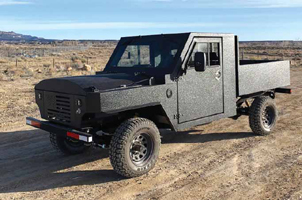 The Small Boss Buggy features a Tier 4-Final engine with streamlined
The Small Boss Buggy features a Tier 4-Final engine with streamlined
electronics. To facilitate maintenance and
cut costs, it has neither a diesel
particulate filter nor diesel exhaust fluid. (Photo: Genco)
The topmost benefit offered is the
safety of the teleremote operation. “Distancing
the operator from the blockage
area and providing them with an effi
cient, effective solution to clear the
blockage keeps the operation moving
smoothly without compromising safety,”
Ojala said.
“Our radio remote control allows the
operator to be underground with options for either line-of-sight or at a further distance
using teleremote operations,” he
said. “The remote-control system is intuitive,
and operators can refine their feel for
the controls as they use them.”
The cannon’s design led to several
unit orders in recent years.
The A64 HD Water Cannon is ideal for
block-caving operations. “This product is
dedicated specifically to this application
and is uniquely suited in the market to
be a safe and efficient alternative to other
clearing techniques,” Ojala said.
The water cannon exemplifies Getman’s
mission: helping miners work
safe, Ojala said. “While we offer a broad
range of standard production and production
support products, we are adept
at developing novel solutions for the
challenges our customers face in this
dynamic industry.”
Scout Speeds Techs to Worksites
J.H. Fletcher & Co. announced the U.S.
debut of the Mine Scout Supervision
Vehicle. The company said the unit is a
rapid-deployment supervision vehicle for
transporting two people between underground
and surface operations.
“It is equipped with ample storage
space for tools, spare parts and testing
equipment,” Francois Meintjes, associate
director, international sales, J.H. Fletcher,
said. “It was designed with maintenance
in mind, with easy-to-access service
points.”
The unit offers speed and peace of
mind. With industry-leading safety features,
“the vehicle is a comfortable ride,
and conserves operator energy when
compared to walking or carrying tools by
hand,” Meintjes said. “This enables the
service technician to do a top-quality repair
job in a shorter amount of time.”
The Mine Scout features a robust
chassis and world class components, the
company reported. It can run for “up to
10,000 hours before an overhaul is required,”
Meintjes said.
“When overhauled by J.H. Fletcher,
the vehicle can achieve an additional
6,000 engine hours,” he said. “The longevity
of the Mine Scout and ability to
have a second service life sets it apart
from its competitors and promises the
customer the lowest running cost.”
The unit was co-developed with manufacturer
UV Botswana to help African
miners do more with fewer technicians
and tools. “It was developed after observing,
at a customer site in Zimbabwe,
that a service technician wastes up to
26% of a 10-hour shift on walking,”
Meintjes said.
“To make matters worse, the only
rapid-deployment vehicles commercially
available are ATVs, side-by-sides and
light-duty trucks,” he said. “These commercial
vehicles are not purpose-built for
mining and lack the required durability
and operator protection one might expect
from a mine compliant vehicle.”
The Mine Scout “gets you to the workplace
faster and safer than ever before,”
he said.
J.H. Fletcher reported seeing interest
in the vehicle from customers in Africa.
UV Botswana “has successfully secured two orders for a platinum mining customer
in central Zimbabwe, with another
two orders lined up for early 2021,”
Meintjes said.
The vehicle demonstrates how J.H.
Fletcher solutions add value by improving
efficiency, job satisfaction and more,
he said. “With the addition of the Mine
Scout, Fletcher expands its priority of
safety to general transportation in the underground
mining industry,” he said.
J.H. Fletcher will be showcasing the
Mine Scout at exhibits throughout the
western U.S. in 2021.
Simple Engine for
Easy Maintenance
Genco Mine Service (Genco) reported its
Heavy Duty 12-Passenger Truck has a Tier
4-Final engine that is simple and easy to
maintain. Featuring streamlined electronics,
it doesn’t have a diesel particulate
filter (DPF) and doesn’t require diesel exhaust
fluid (DEF).
Instead, the engine uses exhaust gas
recirculation and diesel oxidation catalyst
technologies.
With exhaust gas recirculation, exhaust
is fed into the air intake, cutting
the incoming oxygen and making for
lower-temperature combustion, which
can reduce the creation of nitrous oxides
(NOX) by much as 70%.
Diesel oxidation catalyst technology
moves exhaust through a honeycomb of
reactive metals that oxidize carbon monoxide,
gaseous hydrocarbons, and any unburned
fuel and oil. Basically a catalytic
converter, it can cut emitted particulate
volumes in half.
The engine electronics are all built inhouse
by Genco and allow for rapid troubleshooting,
the company said.
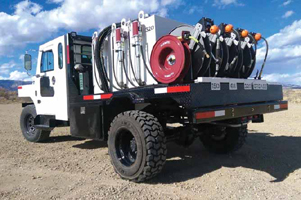 With a Tier 4-Final Engine, the HD Series Lube Truck has four wheel drive,
With a Tier 4-Final Engine, the HD Series Lube Truck has four wheel drive,
straight tube axles and dual-piston
hydraulic steering. (Photo: Genco)
“This should be a big help for the
hard rock miners: Having a simple piece
of equipment,” David Sebring, president,
Genco, said.
The company determined in 2016 it
would offer a Tier 4-Final engine as an option
in all of its underground equipment.
“At the time, Tier 4-Final was on the horizon,
so we decided as a company to get
ahead of the game,” Sebring said.
Genco determined that, from a maintenance
technician perspective, ideal
would be a solution with no DPF and
no DEF.
Typically, a DPF pipes exhaust through
a ceramic sponge, which traps carbon and
converts NOX to NO2. DEF converts NO2 to
ammonia. Lastly, a catalyst converts the
ammonia into nitrogen and water.
A DPF is a complex serviceable, requires
specific expertise to maintain,
and, when malfunctioning, can damage
an engine. DEF is a consumable and,
thus, an expense. Genco sought alternative
technologies.
“Working with Cummins we found that
the QSF 2.8L didn’t require DEF or a DPF
and it would still meet Tier 4-Final requirements
by using diesel oxidation catalyst
technology only,” Sebring said. “We
started development in March 2016.”
The process took several months and
presented challenges, he said. “We first
had to apply for the application, and once
it was approved we had to work with Cummins
Engineers to design the truck,” he
said. “Lastly we had to build the truck,
and spend a week testing it.”
The result is a 74-hp (55-kW) engine,
offering 221 lb-ft (or 300 N-m) torque,
that is easier and cheaper to maintain.
Genco showcased it at MINExpo.
“Our solution is distinguished by
its simplicity and standardization,”
Sebring said.
Standardized parts are readily available.
“We have many different models
that all use the same components and
this becomes a competitive advantage
for the mines when it comes to downtime
and warehouse stocking,” he said.
Further, the engine is “easy to work
on,” Sebring said. “The result is a more
dependable machine.”
As featured in Womp 2020 Vol 12 - www.womp-int.com







